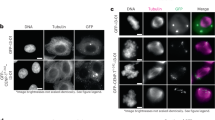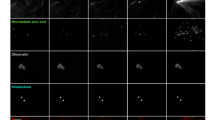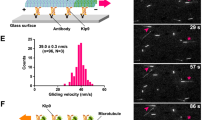Abstract
The kinetochore is a specialized structure at the centromere of eukaryotic chromosomes that attaches chromosomes to the mitotic spindle1,2. Recently, several lines of evidence have suggested that kinetochores may have more than a passive role in the movement of chromosomes during mitosis and meiosis. Kinetochores seem to attract and 'capture' microtubules that grow from the spindle poles and microtubules may lengthen or shorten by the addition or subtraction of tubulin subunits at their kinetochore-associated ends3–6. An attractive hypothesis is that kinetochores function as 'self-contained engines running on a microtubule track'5. Here, we show that kinetochores can be experimentally detached from chromosomes when caffeine is applied to Chinese hamster ovary cells that are arrested in the G1/S phase of the cell cycle. The detached kinetochore fragments can still interact with spindle microtubules and complete all the mitotic movements in the absence of other chromosomal components. As these cells enter mitosis before DNA synthesis is completed, chromosome replication need not be a prerequisite for the pairing, alignment and segregation of kinetochores.
This is a preview of subscription content, access via your institution
Access options
Subscribe to this journal
Receive 51 print issues and online access
$199.00 per year
only $3.90 per issue
Buy this article
- Purchase on Springer Link
- Instant access to full article PDF
Prices may be subject to local taxes which are calculated during checkout
Similar content being viewed by others
References
Brinkley, B. R., Tousson, A., Valdivia, M. M. in Aneuploidy, Etiology and Mechanisms (eds Dellarco, V. L., Voytek, P. E. & Hollaender, A.) 243–368 (Plenum, New York, 1985).
Rieder, C. L. Int. Rev. Cytol. 79, 1–58 (1982).
Pickett-Heaps, J. D., Tippit, D. H. & Porter, K. R. Cell 29, 729–744 (1982).
Mitchison, T. L., Evans, L., Schulze, E. & Kirschner, M. Cell 45, 515–527 (1986).
Gorbsky, G. L., Sammak, P. J. & Borisy, G. G. J. Cell Biol. 104, 9–18 (1987).
Gorbsky, G. L., Sammak, P. J. & Borisy, G. G. J. Cell Biol. 106, 1185–1192 (1988).
Schlegel, R. & Pardee, A. B. Science 232, 1264–1266 (1986).
Nicklas, R. B. in Aneuploidy, Etiology and Mechanisms (eds Dellarco, V. L., Voytek, P. E. & Hollaender, A.) 183–195 (Plenum, New York, 1985).
Ostergren, G. Hereditas 37, 85–156 (1951).
Davis, F. M., Tsao, T. Y., Fowler, S. K. & Rao, P. N. Proc. natn. Acad. Sci. U.S.A. 80, 2926–2930 (1983).
Author information
Authors and Affiliations
Rights and permissions
About this article
Cite this article
Brinkley, B., Zinkowski, R., Mollon, W. et al. Movement and segregation of kinetochores experimentally detached from mammalian chromosomes. Nature 336, 251–254 (1988). https://doi.org/10.1038/336251a0
Received:
Accepted:
Published:
Issue Date:
DOI: https://doi.org/10.1038/336251a0
This article is cited by
-
Mechanisms driving acentric chromosome transmission
Chromosome Research (2020)
-
Kinesin-5 Mediated Chromosome Congression in Insect Spindles
Cellular and Molecular Bioengineering (2018)
-
Mitotic spindle assembly in animal cells: a fine balancing act
Nature Reviews Molecular Cell Biology (2017)
-
Selective tracking of template DNA strands after induction of mitosis with unreplicated genomes (MUGs) in Drosophila S2 cells
Chromosome Research (2013)
-
50 ways to build a spindle: the complexity of microtubule generation during mitosis
Chromosome Research (2011)
Comments
By submitting a comment you agree to abide by our Terms and Community Guidelines. If you find something abusive or that does not comply with our terms or guidelines please flag it as inappropriate.



